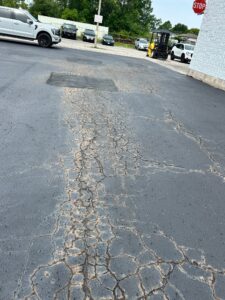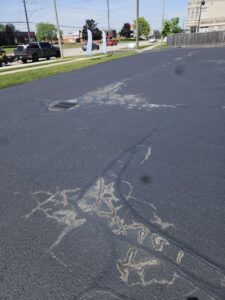Understanding and Addressing the Discoloration of Sealer Around Cracks in Asphalt: Causes, Effects, and Solutions
Maintaining the aesthetic and functional integrity of your asphalt surfaces, whether they be parking lots or driveways, is crucial. One of the more perplexing and common issues that can arise is the discoloration of sealer around cracks in the asphalt. This phenomenon, often manifesting as a brown or white hue around the sealed cracks, can detract from the visual appeal and indicate underlying problems  with moisture and sealant application. In this blog post, we’ll dive into the causes, effects, and solutions for this discoloration, with a special focus on the challenges faced in areas with high humidity and during the early spring season.
with moisture and sealant application. In this blog post, we’ll dive into the causes, effects, and solutions for this discoloration, with a special focus on the challenges faced in areas with high humidity and during the early spring season.
The Cause: Moisture and Hydraulic Pressure
If you find yourself asking the question Why are the asphalt cracks I just sealed over turning brown? The primary culprit behind the discoloration of sealer around cracks is moisture. When water seeps into the cracks in asphalt, it can be drawn up to the surface through a process known as hydraulic pressure. This is especially problematic in regions that experience high humidity or frequent rainfall, such as Ontario summers or early spring, where the constant influx of moisture can exacerbate the issue.
High Humidity and Moisture Intrusion
In areas with high humidity or during springtime, the atmosphere is laden with moisture, which can easily infiltrate the cracks in the asphalt. When the sealcoat is applied, this moisture can be drawn to the surface, causing a brown discoloration around the cracks. This is more likely to occur if the sealcoat did not have sufficient time to cure properly before nightfall when temperatures drop and moisture levels rise. To speed up curing time you can consider additives such as Diamond Shield Fortifier (check with your sealcoat supplier to confirm compatibility)
Hydraulic Pressure and Early Spring Challenges
During the early spring, the ground is often very wet, making it difficult to complete sealcoating work. Parking lots may stay wet longer due to a high water table, leading to asphalt crack discoloration. As the sun heats the pavement, moisture is drawn back to the surface, re-emulsifying the sealer and causing brown discoloration. Additionally, white discoloration may occur due to salts from winter deicers or natural earth salts (efflorescence).
The Effects: Premature Wear and Aesthetic Degradation
The consequences of sealcoat discoloration are twofold. First, the aesthetic appeal of the asphalt surface is compromised. The brown or white  discoloration and mineral deposits create an unsightly appearance that detracts from the overall look of your work. Second, and more importantly, the integrity of the sealcoat is compromised. Sealcoat near cracks that haven’t cured properly is prone to wearing off quickly, reducing the protective barrier that the sealcoat provides.
discoloration and mineral deposits create an unsightly appearance that detracts from the overall look of your work. Second, and more importantly, the integrity of the sealcoat is compromised. Sealcoat near cracks that haven’t cured properly is prone to wearing off quickly, reducing the protective barrier that the sealcoat provides.
The Solution: Proper Preparation and Application
To mitigate the issue of sealcoat discoloration around cracks, it’s essential to focus on proper preparation and application of the sealcoat. Here are some key steps to consider:
Prioritize Crack Sealing
Before applying a sealcoat, it’s crucial to address any cracks in the asphalt. Cracks that are 1/4″ or larger should be prioritized for crack sealing. Crack sealing involves filling the cracks with a flexible, rubberized sealant that prevents water from infiltrating the asphalt. This step is essential for preventing moisture from seeping into the cracks and causing discoloration of the sealcoat. You can apply hot pour or cold pour crack filler to these areas. Hot pour crack filler will always last longer and will require the use of a crack fill melter / applicator. 
Ensure Proper Curing Conditions
The timing and conditions of the sealcoat application play a significant role in preventing discoloration. To ensure proper curing, aim to apply the sealcoat during a period of lower humidity and moderate temperatures. This allows the sealcoat to cure thoroughly before nightfall, reducing the risk of moisture being drawn to the surface. Avoid applying the sealcoat immediately before rain is expected or during periods of high humidity, as these conditions increase the likelihood of moisture-related issues.
Clean and Prepare the Surface
Thoroughly cleaning the asphalt surface before applying the sealcoat is essential. Remove any debris, dirt, and existing mineral deposits from the cracks to ensure that the sealcoat adheres properly and cures evenly. This step helps to minimize the risk of moisture being trapped beneath the sealcoat, which can lead to discoloration and premature wear.
Best Practices for Spring Sealcoating
Sealcoating in the early spring brings additional challenges due to cool nights, increased rain, and leftover winter maintenance materials like sand and salt. Contractors should start the season with repair work, ensuring all surfaces are properly prepared. Educating customers about potential problems can help manage expectations and create opportunities for additional maintenance work, such as crack sealing and patching.
Conclusion
Discoloration of sealer around cracks in asphalt is a common issue, especially in areas with high humidity, frequent rainfall, and during the early spring season. Understanding the causes and effects of this phenomenon is crucial for maintaining the integrity and appearance of the asphalt surfaces you work on. By prioritizing crack sealing, ensuring proper curing conditions, and thoroughly preparing the surface, you can minimize the risk of sealcoat discoloration and enhance the longevity and durability of the asphalt.
In summary, the key to preventing sealcoat discoloration is proper preparation and application. Addressing cracks and ensuring that the sealcoat cures properly are essential steps in maintaining the aesthetic appeal and functional integrity of the asphalt surfaces. By managing customer expectations and educating them about these processes, you can keep your clients happy and ensure their parking lots and driveways look great and stay protected for years to come.
